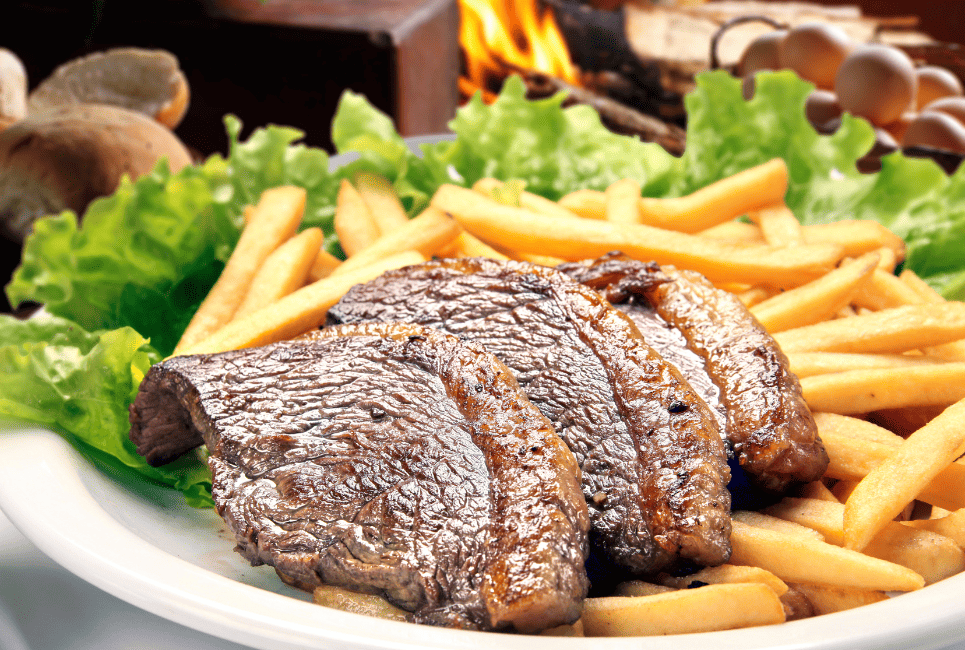- How to Cook Steak on a Pellet Grill: The Ultimate Grilling Medium - November 24, 2022
- How to Cook Wagyu Picanha - November 23, 2022
- How to cook a shell steak: An Uncommon Yet Delicious Cut - November 21, 2022
Wagyu Picanha: One of Brazil’s Favorite Steaks
Not many cuts of meat are sought after more than the Wagyu Picanha. This beautiful steak is revered for its intramuscular fat content, exquisite flavor, and excellent versatility in ingredients it can pair with. The steak is prized in the country of Brazil for grilling and skewers.
The word “picanha” literally translates to “top rump cap.” This cut tends to be more expensive due to its difficulty, and it can be found for $35-50 per ounce at a steakhouse. The steak is prized due to its marbling, or dispersion of fat, along with the layer of fat that sits on one side of the steak.
In this article, I will share why cooking this steak yields a fantastic final product. I will also describe why you should cook it using specific methods and what items can best be paired with it. The bottom line is that this delicious steak has a few stellar cooking methods that allow it to shine.
The Bottom Line Up Front
The best way to cook Wagyu Picanha is by searing it over high heat and cooking it to medium rare. Searing this cut allows the fat to render, caramelization to occur, and showcases the flavor and depth of textures within the meat.
Wagyu: What is it Anyway?
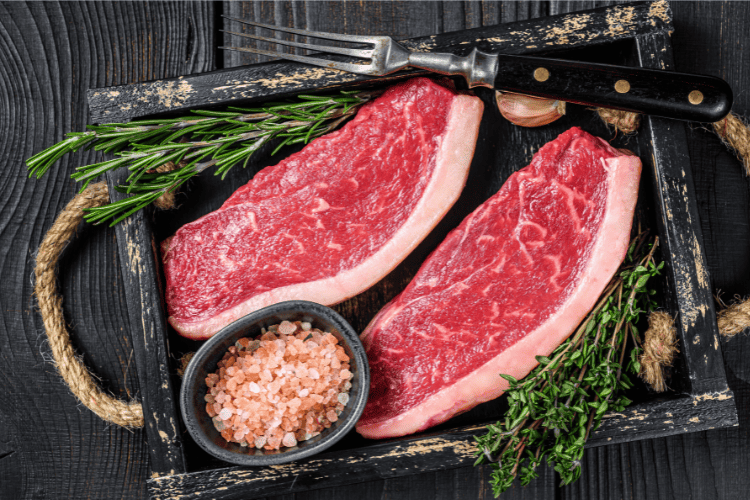
Before we get into the cooking aspect of the steak, I first want to spend some time going over the Wagyu and why it is so sought after in the culinary world. I see many customers getting sticker shock when ordering a Wagyu cut, and this lack of education on the product leads many to steer away from offerings with this steak.
Wagyu is a breed of Japanese cattle raised with the intention of creating high-quality cuts of steak. In Japan, the species are tested at a genetic level to sort out only the highest quality of cattle for this type of meat processing.
Wagyu cattle started to be imported into the states in the 1970s. Since then, the popularity of this cut has grown to a cult-like following. The meat is not cheap, but getting your hands on some allows for a delicious dining experience.
The Wagyu Process
A specialty breeder raises the cattle used for Wagyu, and they are raised until about 7 to 10 months old of age. They will then be sold to a designated farm specializing in raising this breed of cattle to create very high-quality beef.
Cows raised for Wagyu consumption live a life of luxury beyond any other cattle. They live in stress-free environments, as a stressed environment will make the meat tough and less desirable. Some breeders will even brush or massage cows to ensure circulation and proper blood flow throughout their bodies.
They are fed a specific diet and will be provided this for about three years, during which they will be processed. Each cow is named and can be traced back to birth to ensure the proper chain of care is followed. The price tag for Wagyu demands a rigorous rearing process for all cattle that will fall under this designation.
As you can see, so much care and thought to go into raising cattle for this style of beef. Furthermore, the cost of this product reflects the meticulous detail put into it and therefore demands proper cooking techniques to maximize your investment.
Wagyu Grades
Much like other food items, there is a grading scale for Wagyu beef for consumers to use when choosing their next steak or cut of meat. This scale is widely used and is a great way to anticipate quality and cost.
Understanding the “A5” Grade
If you spend any time searching for Wagyu beef or talking with producers selling it, you may come to realize that some of the best options to buy are graded “A5”.
The letter “A” stands for the yield grade. The “5” represents the highest possible grading of quality on a scale from 1-5. So that means this steak is best in yield, marbling, texture, and overall taste when cooked.
Wagyu Picanha Cooking Equipment
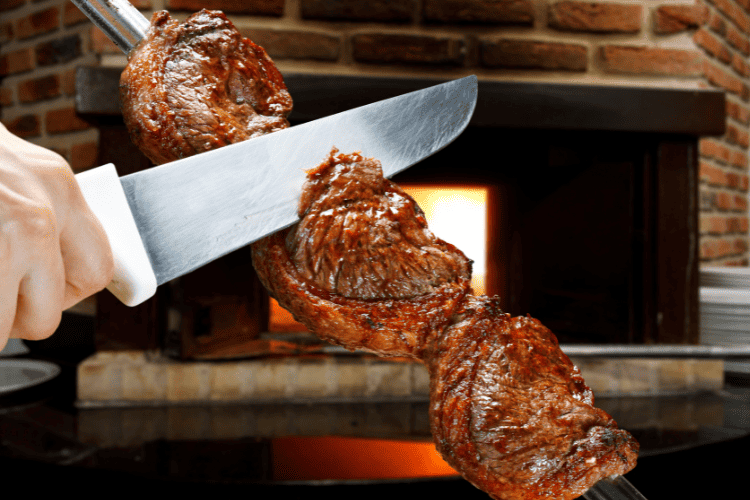
Now that we have a better understanding of the product we are cooking, I will now start to break down the best ways to cook this cut of steak. Before we get into the actual methods, I want to go over some equipment that can be used to cook this cut of beef.
The Grill (and Rotisserie Set Up)
One of the best ways to maximize the flavor of the Picanha is by using a grill. Grills offer a smoky flavor, different temperature zones, and the ability to sear and lock in taste in your favorite cut of meat.
Some types of grills that can be used for this cut are:
- Gas Grills
- Wood Fire Grills
- Pellet Grills
- Charcoal Grills
If you decide to use a woodfire grill, then there are also some specific types of wood that can be used. I would suggest any of these below:
- Hickory
- Mesquite
- Oak
- Pecan
- Cherry
- Peach
I personally enjoy Hickory for a cut like this. The flavor the smoke imparts pairs really well with the fat of a steak like the Picanha. The smoke flavor locks into the bands of fat marbled around the steak, giving a beautifully delicious flavor.
I add a rotisserie stick for a particular method that is both traditional and really adds a ton to this cut. We will go over this in the cooking method section.
The Oven and a Pan
If you do not have access to a grill, the next best option is a hot pan to sear the steak in and an oven to finish. This process is simple, searing the steak to caramelize and render fat and then finishing in the oven to reach the desired temperature. While it will not compare to how much flavor a grill will provide, it will deliver an incredibly delicious steak.
Wagyu Picanha Cooking Methods
Traditional Skewer Method
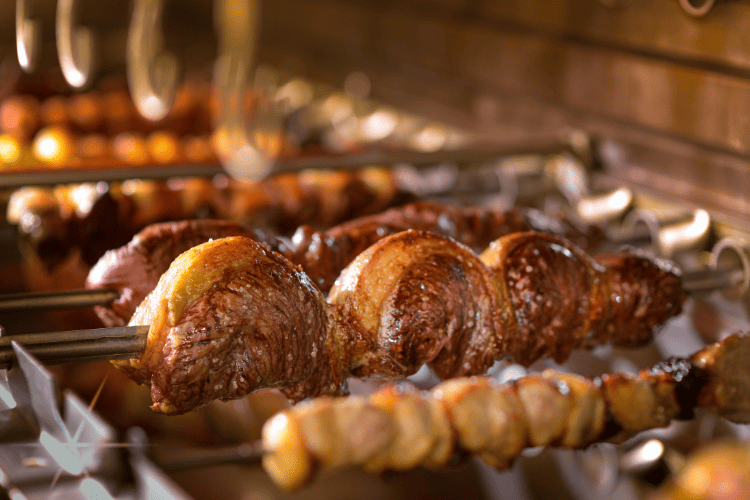
One of the most famous ways you will see the Wagyu Picanha served is in Brazilian steakhouses on skewers. The meat is often cut, placed on a skewer, and cooked over an open flame. This delicious way of cooking protein is famous for a few reasons.
For one, it renders the fat over time over the fire. This makes all of the fat within the steak melt and adds a ton of flavor to the dish. The thick fat cap on the steak becomes caramelized and is similar to how crispy bacon can be, with tender pieces of delicious fat throughout the bite.
This also allows for excellent heat control and the ability to cook to a solid temperature range for optimal eating and serving. The skewer method is prevalent in Brazil and is not to be missed when trying this steak.
To start, you will want to start your fire and get your rotisserie set up and ready to go. You then want to cut your Picanha steak with the grain of the meat, about 1 ½ to 2 inches thick.
This ensures a good fat cap on all slices and durability to be cooked over the flame. You then place these pieces on a skewer and season with oil, salt, and pepper.
Mastering the Flame
Once your Picanha is seasoned and skewered, ensure the flame is at medium heat. You will then place the meat directly over the coals and turn for about 15 minutes. The steak should be caramelized and seared. The fat should be golden brown, and the steak tender and juicy.
The key to this method is that it is a continuous cooking method and serving process until the steak is fully cooked. Once the outside layer of beef is golden brown and ready, you take a long slicing knife and thinly slice the cooked-out layer of the skewer. This slice should be thin and only take off the cooked portion of the meat.
Once you have sliced the skewer, place it back over the fire to cook again. You repeat this until the skewer is fully cooked and sliced. The slices should be eaten immediately for the best flavor.
The beauty of this way of cooking the Picanha is that each bite you have is paired with a tender, juicy feel and the crisp, caramelized exterior of fat. It is also a very communal way to eat the steak and one that has become so popular with this cut.
Open Flame Grill Method
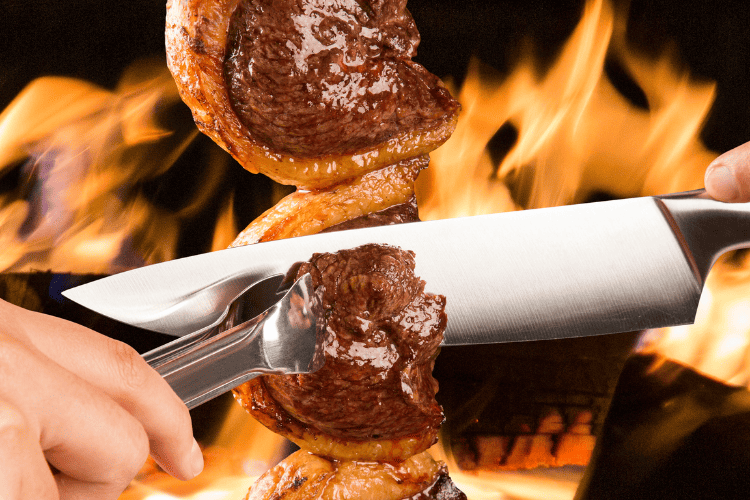
The following cooking method with the Wagyu Picanha is leaving it whole and grilling it as you would any other steak. Depending on the size of the cut, you can leave it whole or cut it against the grain into smaller pieces. Regardless, before grilling, you want to allow this cut to “temper” at room temp for about 30 minutes.
After tempering, score the steak by running your knife through the fat horizontally and then vertically. This will help with rendering and allow much crispier skin and an overall better sear. When scoring, be sure not to go into the meat itself. Just stay within the layer of fat.
Season with oil, salt, and pepper, and find the hottest part of your grill. Place the steak there and allow to sear for 2-3 minutes on the fat cap first. When that side is golden brown, turn over and continue to sear on the other side.
Ensure the steak is golden brown on all sides. Move to a medium heat portion of the grill and cook until medium rare, about 130-140F.
When the steak is done, it is essential to allow it to rest for 5-10 minutes before serving. This is due to the energy in the steak still moving around due to the high heat.
When you let steaks rest, the juice settles evenly inside the meat, and the color turns out much better. Cut too early, and you risk causing the steak to dry out and lose a ton of the flavor you worked so hard for when cooking.
Pan and Oven Sear
This method closely follows the approach above, barring the fact we are not using an open flame but rather a pan on the stove and an oven. Preheat your oven to 350F, and a saute pan to medium-high heat. Remember to have your steak tempered before doing this process, along with scores added into the fat.
Pat the steak dry prior to searing. Season the steak with salt and pepper and add some vegetable oil to the saute pan. Wait for the oil to smoke white, and then place the steak in the pan, allowing the cut to fall away from you to avoid oil splashing back onto your hand.
Sear on this side for 2-3 minutes or until golden brown, then flip and sear on the remaining sides. When this is done, place the steak on a sheet tray with an oven rack. Place into the oven and cook to your desired temperature( 135F recommended). Allow resting when done and to serve.
Sauces to Serve with Wagyu Picanha
The Wagyu Picanha cut is great because it can be relatively simple to make and does stand independently due to its flavor, marbling, and overall texture. So to enjoy, I have added below some sauces you can add when eating this excellent steak cut:
- Chimichurri
- Bearnaise
- Dijon Mustard Sauce
- Chipotle Aoili
- Compound Butter
Sides Served with Wagyu Picanha
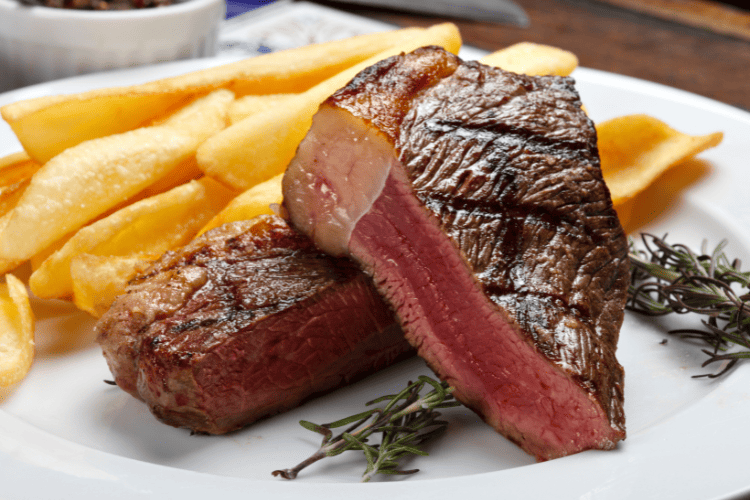
A full meal would not be so without some great sides. Below are some sides ideas to serve along with the cut of meat you worked so hard on cooking:
- Roasted Vegetables
- Roasted Mushrooms
- Refried Beans
- Brazilian Potato Salad
- Collard Greens
- Rice
FAQ’s
Answer: While fat has a negative connotation with it nowadays, it is the piece of meat that gives the most flavor. That is why the highest-graded Picanhas are full of intramuscular fat. The fat equals flavor and is the star of the show with these steaks.
Answer: The fat on an A5 Wagyu Picanha is tender and quite simply delicious. This fat melts and renders into beautifully crisp bites with the proper heat applied. The whole goal of this cut is to achieve this, and chewiness is not a concern when appropriately cooked.
Answer: The difference between the beef you get at a grocery store vs. a cut made from the Wagyu method is night and day. Flavor, texture, appearance, and overall quality are all displayed for Wagyu beef compared to the commercially raised product. The difference is extreme and is reflected in the price.
In Conclusion
The Wagyu Picanha cut is popular due to its prestigious designation, excellent flavor, and rarity of find. It is a genuinely delicious cut of beef to get your hands on, and you should feel lucky if you do.
If you ever have the opportunity to cook the Wagyu Picanha, searing on high heat to showcase the marbling and flavor is your best bet.

